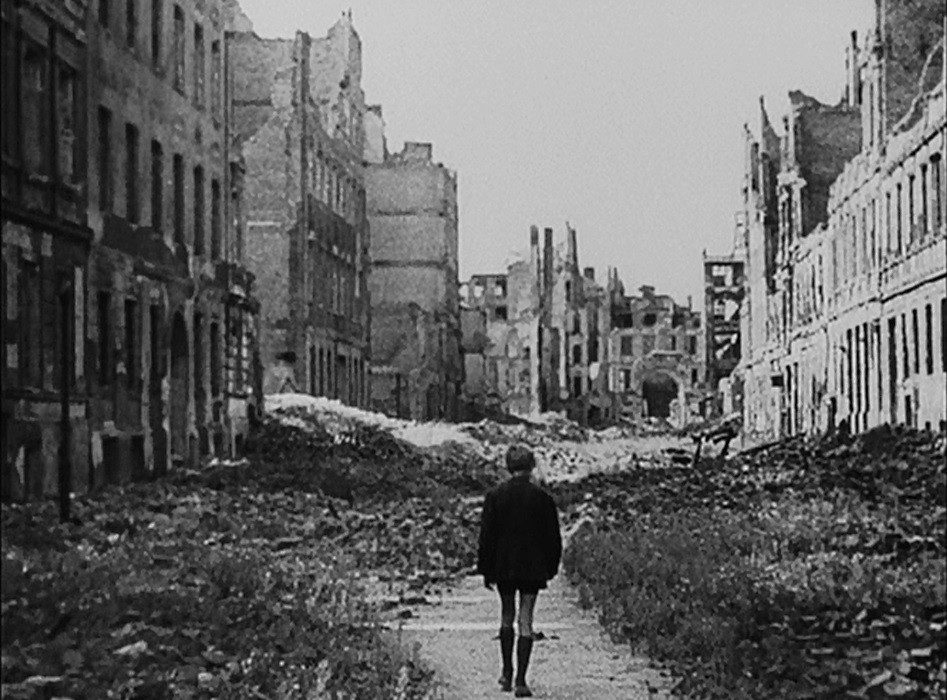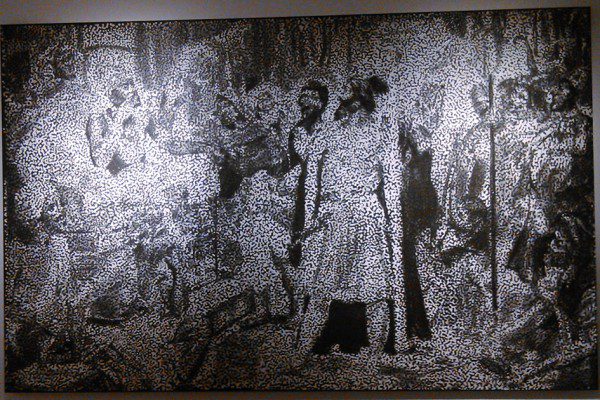Roberto Rosselini’s Germany Year Zero (1948) is set in post war Germany in depression. A classic Italian Neo-realist film, it shows the city that is all rubbles and pieces, left like a royal standing cadaver. In the opening sequence, the camera captures people digging in what looks like a quarry perhaps. But look closer and we see they are digging graves. On the way back, the boy encounters a group of men around a dead horse, with knives, squabbling for a piece of it’s still tender meat. The boy shouts ‘I want a piece too!’ He walks back and the camera stays to capture the larger frame; of the little boy walking down a street of empty facades of ruined buildings bombed and decrepit.
You don’t really need an apocalyptic scenario to imagine a ruin. Ruins are intrinsic to time. Time and aging. And with the postmodernists, it is almost a fetish.
While reflecting on the writing of Hans Erich Nossack and Hermann Kasack, two writers amongst the few who attempted a literary account of the episodes of total destruction, W.G.Sebald in the book Campo Santo says that the monumental theatrical scene of a ruined city presented to an observer passing by, reflects an architectural plan: for all their evocation of eternity and their enormous size, their design contained within itself the idea of a style of building that revealed all its grandiose aspirations only in a state of destruction. In view of the utter catastrophe there seems to be something scandalous about the “feeling of happiness” that he experiences, on the drive “toward the dead city”.
Here is an act of walking through derelict and broken spaces, spaces that ultimately could not withstand acts of time, human or natural and thereby stand helplessly on display, like cemeteries of cities without ceremony.
There is no standing in these places. Standing is almost shameful for the sensitive, standing involves a moment of interest and watching, standing would be indulgent – a centred moment of focus allowing oneself the privilege of paused time in the presence of those that have had not. A necropolis stands in such helplessness perhaps with that mixed feeling when one is not sure if it is getting the right kind of attention. A shy city, a hesitant city, a city that is walking backwards, a city where all the people have left the building; and the building is the last one standing.
Some cities have had the partial privilege of a blank slate head start after turning into ground zeroes under devastating bombing during the war. They have to rebuild from scratch a possibility that is impossible to achieve in the case of other cities that were not annihilated but ruined, ravaged and weakened. To be weakened in a fight is a sure way of conquest than to have died valiantly. Such was the fate of these half weakened cities.
Exodus, or the Voluntary Prisoners of Architecture, the architectural thesis of the witty urban designer-architect Rem Koolhaas, speaks of this weakening and impending disaster – a mocking of architecture in the face of invincible design for better lifestyle. The thesis replicates a model of human intervention with the sole aim of reducing a perfectly working machinery of a city like London to ruins.
Can design be sarcastic and critical? It is quite rare to come across design that explores this critical edge, that does not serve or solve but questions and negates.
“Suddenly, a strip of intense metropolitan desirability runs through the centre of London. This strip is like a runway, a landing strip for the new architecture of collective monuments. Two walls enclose and protect this zone to retain its integrity and to prevent any contamination of its surface by the cancerous organism that threatens to engulf it. Soon, the first inmates beg for admission. Their number rapidly swells into an unstoppable flow. We witness the Exodus of London. The physical structure of the old town will not be able to stand the continuing competition of this new architectural presence. London as we know it will become a pack of ruins.”
– Rem Koolhaas, Voluntary Prisoners of Architecture
The esplanade mansion in the Kalaghoda district in Mumbai, the Opera house near Grant road, the many vacated three and four storied apartments, plastered and cello taped with cement before they crumble through their cracks, the decrepit concrete structures perennially in waiting, the leaking ceilings and peeling plasters all signal a perforated situation. Fissures and cracks that stand for a strength bygone and a potential outgrown, a limit condition reached and outdone.
The city grows through certain stages in its life cycle – as a metropolis, a megapolis, a cosmopolis and the final stage beyond which there is only rebirth – the necropolis, where it has reached the peak of its evolution curve. What happens next? The machinery begins to ingest itself, and ruminate on its own remains, in the manner of the ouroboros, the end and the beginning all coinciding into one large apocalyptic blur.
In Roman Polanski’s The Pianist, the delicate fingers of a piano player come in touch with concrete rubble of catastrophe of the war. It captures perhaps the widest range of human dissonance and absurdity of man’s actions. The poster most probably inspired from many shots of Germany Zero Year mimics a biblical image, where Moses with the tap of his wooden staff, parts the ocean and walks through. Walking, in that sense is a clearing of space with one’s presence.
Many recent articles have been revisiting and talking about the rise, the demise, the end and the re-birth of the figure of the flaneur in every way possible, some speak in praise of walking, others speak of the death of walking as it was. But the walker persists though not without intimidation and being overwhelmed by technological chaos.
Walking in an Indian city is an adventure but a necessary one. With the intersection and breaking down of more and more cities with metro lines and monorails, the walker will now perhaps get more opportunities to walk the more she jostles in between nodes and stations.
Walk back, retrace, slide along, skip and crawl, tiptoe and side-hop through the shuffling city. There are many ways of moving in this city, many ways of chasing, many ways of sulking and sleepwalking, and many ways of twirling through zebra crossings, in this city there are indeed many ways of walking, but kindly, no standing.














